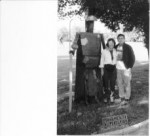Learning about ‘green’
The largest sign in the campus center read “229 million tons . that’s how much waste Americans generate every year.” Saving the earth is a daunting task, but Castleton is taking that challenge one day at a time.
On Oct. 25, the multipurpose room was converted into a showroom of earth-saving ideas. For the first year at Castleton, Sustainability Day brought focus to energy- and waste-saving initiatives.
“This whole movement has kind of exploded,” said Professor Paul Derby, who is spearheading the effort. “Colleges are buying into the need to be more sustainable. It’s crucial that colleges become good examples for the students, employees, and larger community.”
Booths featured composting and food waste reduction at Castleton, a solar and wind power exhibit, biodiesel exhibit, and Central Vermont Power Service (CVPS) detailing ‘cow power.’
“We’re more than happy to participate,” said Christine Rivers from CVPS. “Our farms have 500 to 3,000 cows in free style barns. An anaerobic digester holds waste at 100 degrees for about 20 days and builds up bacteria that create methane gas. The gas burns and creates electricity.”
According to the CVPS Web site, www.cvps.com/cowpower, its farms produce between 1.2 and 3.5 million kilowatt-hours of electricity a year.
Student Sue Gernhardt combined a bit of exercise with her energy-saving lesson from Efficiency Vermont. Gernhardt was just one of many to peddle a bike hooked up to four regular light bulbs, two incandescent and two compact fluorescent bulbs. The peddling produced DC power, lighting the bulbs. Switching from the incandescent to CFL bulbs, Gernhardt was able to produce the same amount of light at 25 percent the work.
“You really can notice the difference,” Gernhardt said.
Across the way, students from Derby’s class were exchanging incandescent bulbs for CFL bulbs. According to Energy Star, CFL bulbs use at least two-thirds less energy and last up to 10 times longer. Furthermore, if every American home used just one CFL bulb, saved energy would be enough to light more than 2.5 million homes a year.
“It was very successful. We exchanged 349 light bulbs,” Derby said. “For one day, that’s great.”
Student Yvette Furnia spent several minutes discussing with one exhibitor the cost efficiency of biodiesel vehicles and comparing them with grease cars.
“Biodiesel cars take out the grease to run cleaner and longer,” said Furnia, whose band is looking to buy a biodiesel van. “It’s the little stuff that counts.”
Huden Dining Hall also participated by serving a lunch of Vermont grown and produced foods, turning off all unnecessary lighting, and conserving water by not using trays.
“Student reaction was mixed. Some were really onboard, appreciated it, and pulled me aside and told me they were going to try it every day, which is great,” said Pete Merritt, director of food service. “Others were vocally load about what an inconvenience not having a tray was.”
Throughout the day, the dining hall staff put aside any white milk that was thrown away. The amount of wasted milk was around 40 gallons.
“I think all we want to do is get people to think about and understand the impact each individual has,” Merritt said.
Having attended events at other campuses, Derby said that this was the most consistently attended one he’d seen. Currently, he said that his class is working with Aramark to draft a plan that would turn the food service’s waste into compost and to serve more local farm products. Furthermore, over the next few years, he looks for the campus to become more sustainable.
“The earth can’t support the abuse we’re doing to it,” he said. “I’m finding that students get it. We’ve put this on you guys and it’s the younger generation that’s going to fix it.





